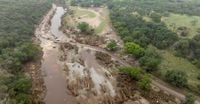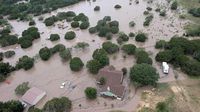Central Texas reels from one of the deadliest flash floods in recent history, as the Guadalupe River surged dramatically on the early morning of July 4, 2025, transforming the serene landscape around Camp Mystic into a scene of devastation and heartbreak. The once-idyllic Christian girls' summer camp, nestled along the riverbank in Kerr County, was ravaged by floodwaters that rose 26 feet in just 45 minutes, sweeping away cabins, belongings, and tragically, lives.
As floodwaters began to recede by July 5, the grim toll became clearer: at least 82 people have died across Texas, including 27 campers and counselors from Camp Mystic, with many more still unaccounted for. State officials reported that 27 girls from the camp remained missing about 36 hours after the flood, underscoring the ongoing desperation and urgency of search and rescue efforts. Governor Greg Abbott, who toured the devastated camp alongside rescue crews, pledged relentless efforts to find the missing, vowing that authorities would "work around the clock" until every survivor was found.
The tragedy unfolded as nearly 10 inches of rain fell overnight in Kerr County, far exceeding the 3 to 6 inches originally forecasted by the National Weather Service (NWS). The Guadalupe River, a beloved natural feature drawing families and campers for generations, became a lethal force as it burst its banks around 4 a.m., sweeping away homes, vehicles, and the low-lying cabins where many of the younger campers slept. The rapid rise caught many by surprise, including local officials who admitted that the scale of the flooding was unprecedented.
Camp Mystic, established in 1926 and cherished for its wholesome Christian environment, was a sanctuary for hundreds of girls aged 8 to 17 seeking adventure, friendship, and spiritual growth. Photos from just days before the flood show smiling campers fishing, riding horses, and performing choreographed dances, a stark contrast to the mud-caked, toppled bunk beds and scattered debris that now define the camp. Survivors like 13-year-old Stella Thompson, who was on higher ground during the storm, described the scenes as "horrific," recalling the terror as floodwaters engulfed cabins and first responders pulled girls from rushing waters.
Despite the National Weather Service issuing flood watches and flash flood warnings in the hours leading up to the disaster, questions have emerged about whether these alerts were sufficient or timely enough to prompt evacuations. The NWS had issued a "life-threatening flash flooding" warning at 1:14 a.m. on July 4, approximately three hours before flooding reports came in. However, some local officials and residents expressed frustration, noting that earlier forecasts underestimated the rainfall and that the county lacked a dedicated flood warning system akin to tornado sirens.
Kerr County Judge Rob Kelly acknowledged the absence of such a system, explaining that attempts to install one years ago were met with public resistance due to cost concerns. "Taxpayers won’t pay for it," Kelly said, adding, "We had no reason to believe this was going to be anything like what’s happened here. None whatsoever." This lack of infrastructure, combined with the storm's rapid intensification, left many unprepared for the scale of the disaster.
Meanwhile, the Texas Division of Emergency Management chief, Nim Kidd, highlighted that the NWS forecasts did not predict the extraordinary amount of rain that fell, noting that initial predictions called for up to six inches, far less than the actual 10 inches recorded. Kidd and other officials have defended their response, but the tragedy has sparked criticism and a broader conversation about emergency preparedness and the resilience of forecasting systems.
Adding to the complexity, the National Oceanic and Atmospheric Administration (NOAA), which oversees the NWS, has faced significant staffing cuts and budget reductions in recent years. Former NOAA and NWS officials warned that these reductions could undermine the agency's ability to provide timely and accurate warnings, although some meteorologists argue that the forecasts issued before the floods were as precise as possible given the storm’s sudden escalation.
Amid the chaos, heroic efforts have shone through. U.S. Coast Guard rescue swimmer Scott Ruskan was credited with saving 165 people during the floods, including many from Camp Mystic. His bravery and that of countless first responders brought some measure of hope to a community in mourning.
The human cost is deeply felt. Among the victims were 8-year-old twin sisters Hanna and Rebecca Lawrence from Dallas, whose grandfather described the loss as "unimaginable." Families across the country are grappling with grief, holding vigils, and searching for answers as the recovery continues.
Camp Mystic’s leadership expressed profound sorrow, stating, "Our hearts are broken alongside our families that are enduring this unimaginable tragedy. We are praying for them constantly." The camp has been a pillar of the community for generations, and its destruction reverberates far beyond the flood zone.
As rescue teams comb through debris, the mission is shifting from rescue to recovery, with rain forecasted to continue complicating efforts. Texas Governor Abbott has vowed that the search will "stop at nothing," underscoring the state's commitment to those affected.
The tragedy at Camp Mystic and across Central Texas serves as a sobering reminder of nature's unpredictability and the critical importance of preparedness and communication in the face of extreme weather. It also raises urgent questions about infrastructure investments, emergency alert systems, and the capacity of forecasting agencies in an era of increasingly volatile climate patterns.
While the community mourns, stories of survival, courage, and solidarity emerge, painting a complex portrait of resilience amid disaster. As the sun sets on this devastating chapter, the people of Kerr County and beyond are left to rebuild, remember, and reckon with the forces that turned a beloved summer camp into a nightmare.



